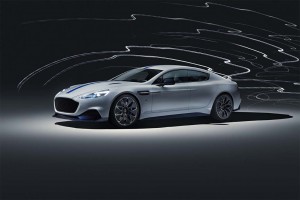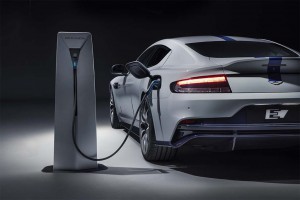
Two years late, Aston Martin debuted its battery-electric speedster, the Rapide E, at Auto Shanghai.
Few countries are plugging into battery-power more rapidly than China, so it would seem appropriate that Aston Martin would bring its first all-electric model, the Rapide E, to Auto Shanghai for its formal debut.
Originally intended to be developed as part of a joint venture with China’s LeEco, the project is nearly two years behind schedule and, with the Chinese start-up pulling out of the project, Aston now plans to build just 155 of the battery-electric vehicles. But it says it will use what it has learned for future BEVs, including both a plug-based version of its upcoming DBX crossover, as well as the Lagonda crossover due out in 2021.
Calling the unveiling of the Rapide E “a huge moment for Aston Martin,” CEO Andy Palmer said that it “signals Aston Martin is prepared for the huge challenge of an environmentally responsible and sustainable future. As a car company we cannot afford to passively allow that future to come to us; we have to actively chase it.
With the pullout of LeEco, which has been struggling to survive, indefinitely delaying its own product programs, Aston turned to Williams Advanced Engineering to complete the development of the Rapide E.
(Aston Martin AM-RB 003 is a high-tech hypercard. Click Here for the story.)
Produced at the British marque’s new factory in St. Athan, the Rapide E is powered by an 800-volt, 65 kilowatt-hour lithium-ion battery pack. Twin motors on the rear axle produce 602 horsepower and 701 pound-feet of torque. That’s enough to launch it from 0 to 60 in the “sub-4-second range,” the automaker claimed, with a top speed electronically limited to 155 mph.
The automaker claims the sports car will be able to travel about 200 miles between charges. That’s using the updated European test standard however and would likely be lower if Aston were to bring any of the Rapid E battery-cars to the U.S., something not considered likely given its low volume.
At first glance, the Rapide E looks much like the standard, gas-powered version of Aston’s four-door model, but for the plug cover that replaces the traditional gas filler door and the lack of the Rapide’s conventional exhaust system.
The BEV has been outfitted with pretty much all the features one could ask for on a standard-issue Rapide, but it also adds some key features in the passenger compartment that distinguish it as an electric vehicle. The conventional analog gauges, for one thing, have been replaced by a 10-inch digital display that provides necessary details about the battery’s state-of-charge charge and motor power levels.
The cabin also features what Aston describes as “swaths” of carbon fiber “assisting in delivering the strict weight targets” needed to maximize range. At 4,717 pounds, the Rapide E still weighs about 400 pounds more than the gas version.
(Click Here to see Aston’s new DBX SUV undergoing testing.)
The Rapide name appears to apply to Aston’s approach to recharging the battery-car, the automaker claiming its battery pack can be fully topped off in less than an hour using a Level 3 fast charging system. The built-in Level 2 240-volt charger can also recharge the batteries in as little as three hours.
The Rapide E engineering team didn’t have the luxury of developing the battery-electric model from the ground up. As a result, the vehicle doesn’t follow the current state-of-the-art approach of using a skateboard-like platform to house the battery pack below its load floor Instead, the lithium-ion cells are packed pretty much anywhere the development team could find space, starting with the engine compartment and the area where a gas tank would normally be mounted. That approach limited the amount of batteries that could be carried – and thus range – while also impacting vehicle dynamics.
Going forward, Aston is expected to go with the skateboard design layout when it adds its next electric vehicle. No hard date has been set for the battery-powered DBX, but it will likely follow a year or two after the conventionally powered version due out a year from now.
As for Lagonda, that new sub-brand will go entirely battery-electric, CEO Palmer has confirmed. Its first model, also a crossover, is due out by the beginning of the coming decade. A show car version, the Lagonda All Terrain Concept, was revealed at the recent Geneva Motor Show.
(Aston Martin Longonda all-terrain concept hints at future.)
All future Aston battery-cars will be produced at the St. Athan’s plant which the automaker has dubbed its “home of electrification.”


